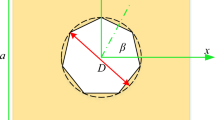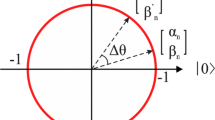Abstract
Optimization with Unified Particle Swarm Optimization (UPSO) method is performed for the enhancement of buckling load capacity of composite plates having damage under hygrothermal environment which has received little or no attention in the literature. Numerical results are presented for effect of damage in buckling behavior of laminated composite plates using an anisotropic damage model. Optimized critical buckling temperature of laminated plates with internal flaw is computed with the fiber orientation as the design variable by employing a UPSO algorithm and results are compared with undamaged case for various aspect ratios, ply orientations, and boundary conditions. FEM formulation and programming in the MATLAB environment have been performed. The results of this work will assist designers to address some key issues concerning composite structures. It is observed that the degradation of buckling strength of a structural element in hygrothermal environment as a result of internal flaws can be avoided to a large extent if we use these optimized ply orientations at design phase of the composite structure. This specific application proves the contribution of present work to be of realistic nature.














Similar content being viewed by others
References
Carrera E (2002) Theories and finite elements for multilayered, anisotropic, composite plates and shells. Arch Comput Methods Eng 9(2):87–140
Chang N, Wang W, Yang W, Wang J (2010) Ply stacking sequence optimization of composite laminate by permutation discrete particle swarm optimization. Struct Multidisc Optim 41(2):179–187
Clerc M, Kennedy J (2002) The particle swarm-explosion, stability, and convergence in a multidimensional complex space. IEEE Trans Evol Comput 6(1):58–73
Dennis Jr JE, Schnabel RB (1996) Numerical methods for unconstrained optimization and nonlinear equations. 16 SIAM, Philadelphia
Fourie P, Groenwold A (2002) The particle swarm optimization algorithm in size and shape optimization. Struct Multidisc Optim 23(4):259–267
Grover N, Singh BN, Maiti DK (2013) New nonpolynomial shear-deformation theories for structural behavior of laminated-composite and sandwich plates. AIAA J 51(8):1861–1871
Hu X, Eberhart R, Shi Y (2003) Engineering optimization with particle swarm. IEEE Swarm Intell Symp, Indianapolis, pp 53–57
Huang J, Haftka RT (2005) Optimization of fiber orientations near a hole for increased load-carrying capacity of composite laminates. Struct Multidisc Optim 30(5):335–341
Kapania RK, Raciti S (1989) Recent advances in analysis of laminated beams and plates, part i: shear effects and buckling. AIAA J 27(7):923–935
Kennedy J, Eberhart R (1995) Particle swarm optimization. In: Proc. IEEE Int Conf on Neural Networks (Perth), IEEE Service Center 4, Piscataway, NJ, 1942–1948
Kundu CK, Maiti DK, Sinha PK (2007) Nonlinear finite element analysis of laminated composite doubly curved shells in hygrothermal environment. J Reinf Plast Compos 26(14):1461–1468
Le Riche L, Haftka RT (1993) Optimization of laminate stacking sequence for buckling load maximization by genetic algorithm. AIAA J 31(5): 951–956
Mantari JL, Oktem AS, Soares CG (2012) A new higher order shear deformation theory for sandwich and composite laminated plates. Compos Part B: Eng 43(3):1489–1499
Mohan SC, Yadav A, Maiti DK, Maity D (2014) A comparative study on crack identification of structures from the changes in natural frequencies using GA and PSO. Eng Comput 31(7):1514–1531
Montazeri A, Poshtan J, Yousefi-Koma A (2008) The use of particle swarm to optimize the control system in a PZT laminated plate. Smart Mater Struct 17:1–7
Pagano NJ, Hatfield HJ (1972) Elastic behavior of multilayered bidirectional composites. AIAA J 10(7):931–933
Pidaparti RMV (1997) Free vibration and flutter of damaged composite panels. Compos Struct 38(1-4):477–481
Prabhakara DL, Datta PK (1993) Vibration and static stability characteristics of rectangular plates with a localized flaw. Comput Struct 49(5):825–836
Pratihar DK (2008) Soft computing. Narosa publishing house Pvt. Ltd., NewDelhi
Premalatha K, Natarajan AM (2009) Hybrid PSO and GA for global maximization. Int J Open Problems Comput Math 2(4):597–608
Rahul R, Datta PK (2013) Static and dynamic characteristics of thin plate like beam with internal flaw subjected to in-plane harmonic load. Int J Aeronautical Space Sci 14(1):19–29
Rao SS (2009) Engineering optimization: theory and practice. 4th edn, John Wiley & Sons, Inc
Reddy JN (2004) Mechanics of laminated composite plates and shells: theory and analysis, 2nd edn. CRC Press, New York
Shin YS, Haftka RT, Watson LT, Plaut RH (1989) Design of laminated plates for maximum buckling loads. J Compos Mater 23(4):348–369
Singha MK, Ramachandra LS, Bandyopadhyay JN (2000) Optimum design of laminated composite plates for maximum thermal buckling loads. J Compos Mater 34(23):1982–1997
Singha MK, Ramchandra LS, Bandyopadhyay JN (2001) Thermal postbuckling analysis of laminated composite plate. Compos Struct 54(4):453–458
Spallino R, Theirauf G (2000) Thermal buckling optimization of composite laminates by evolution strategies. Comput Struct 78:691–698
Sreehari VM, Maiti DK (2015) Buckling and post buckling analysis of laminated composite plates in hygrothermal environment using an inverse hyperbolic shear deformation theory. J Compos Struct 129:250–255
Sreehari VM, George LJ, Maiti DK (2016) Bending and buckling analysis of smart composite plates with and without internal flaw using an inverse hyperbolic shear deformation theory. J Compos Struct 138:64–74
Sukru K, Omer S (2009) Buckling optimization of laminated composite plates using genetic algorithm and generalized pattern search algorithm. Struct Multidisc Optim 39:477–486
Sumathi S, Surekha P (2010) Computational intelligence paradigms- theory and applications using MATLAB. CRC Press
Tang Q, Eberhard P (2011) A PSO-based algorithm designed for a swarm of mobile robots. Struct Multidisc Optim 44:483–498
Valliappan S, Murti V, Zhang W (1990) Finite element analysis of anisotropic damage mechanics problems. Eng Fract Mech 35(6):1061–1071
Walker M, Reiss T, Adali S, Verijenko VE (1997) Optimum design of symmetrically laminated plates for maximum buckling temperature. J Therm Stresses 20(1):21–33
Wang W, Guo S, Chang N, Zhao F, Yang W (2010) A modified ant colony algorithm for the stacking sequence optimization of a rectangular laminate. Struct Multidisc Optim 41(5):711–720
Zhang W, Yunmin C, Yi J (2001) Effects of symmetrisation of net-stress tensor in anisotropic damage models. Int J Fract 109(4):345–363
Zheng Y, Ma L, Zhang L, Qian J (2003) Robust PID controller design using particle swarm optimizer. IEEE Int Symp Intell Control 974–979
Zienkiewicz OC (1971) The finite element method, 3rd edn. Tata McGraw-Hill Publishing, UK
Author information
Authors and Affiliations
Corresponding author
Rights and permissions
About this article
Cite this article
Sreehari, V.M., Maiti, D.K. Buckling load enhancement of damaged composite plates under hygrothermal environment using unified particle swarm optimization. Struct Multidisc Optim 55, 437–447 (2017). https://doi.org/10.1007/s00158-016-1498-y
Received:
Revised:
Accepted:
Published:
Issue Date:
DOI: https://doi.org/10.1007/s00158-016-1498-y




